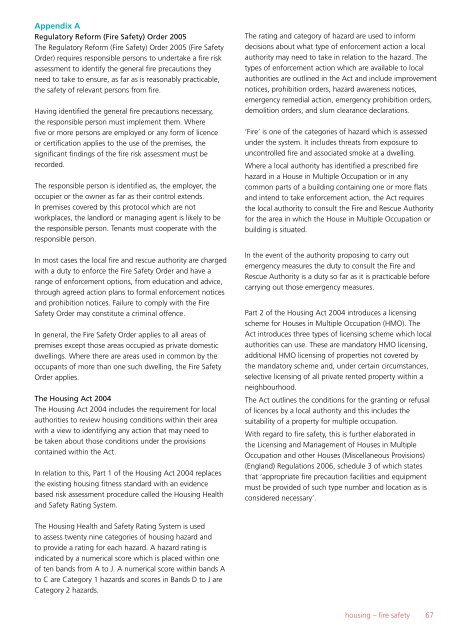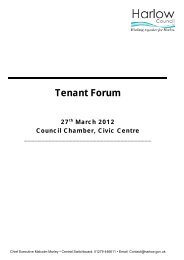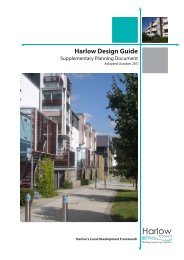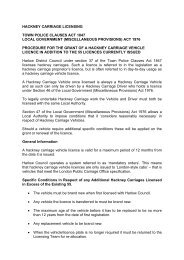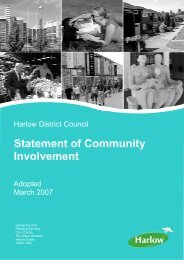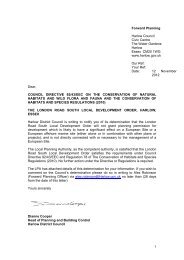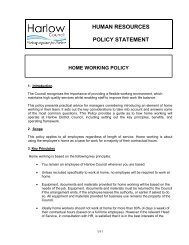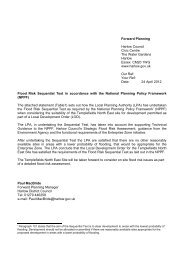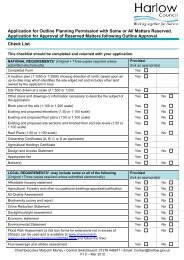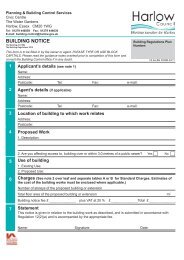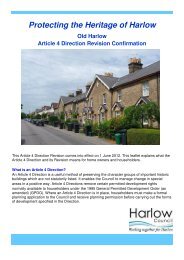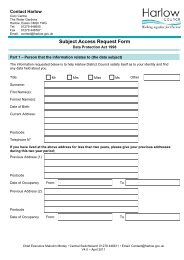HMO fire safety guidance - Harlow Council
HMO fire safety guidance - Harlow Council
HMO fire safety guidance - Harlow Council
Create successful ePaper yourself
Turn your PDF publications into a flip-book with our unique Google optimized e-Paper software.
Appendix A<br />
Regulatory Reform (Fire Safety) Order 2005<br />
The Regulatory Reform (Fire Safety) Order 2005 (Fire Safety<br />
Order) requires responsible persons to undertake a <strong>fire</strong> risk<br />
assessment to identify the general <strong>fire</strong> precautions they<br />
need to take to ensure, as far as is reasonably practicable,<br />
the <strong>safety</strong> of relevant persons from <strong>fire</strong>.<br />
Having identified the general <strong>fire</strong> precautions necessary,<br />
the responsible person must implement them. Where<br />
five or more persons are employed or any form of licence<br />
or certification applies to the use of the premises, the<br />
significant findings of the <strong>fire</strong> risk assessment must be<br />
recorded.<br />
The responsible person is identified as, the employer, the<br />
occupier or the owner as far as their control extends.<br />
In premises covered by this protocol which are not<br />
workplaces, the landlord or managing agent is likely to be<br />
the responsible person. Tenants must cooperate with the<br />
responsible person.<br />
In most cases the local <strong>fire</strong> and rescue authority are charged<br />
with a duty to enforce the Fire Safety Order and have a<br />
range of enforcement options, from education and advice,<br />
through agreed action plans to formal enforcement notices<br />
and prohibition notices. Failure to comply with the Fire<br />
Safety Order may constitute a criminal offence.<br />
In general, the Fire Safety Order applies to all areas of<br />
premises except those areas occupied as private domestic<br />
dwellings. Where there are areas used in common by the<br />
occupants of more than one such dwelling, the Fire Safety<br />
Order applies.<br />
The Housing Act 2004<br />
The Housing Act 2004 includes the requirement for local<br />
authorities to review housing conditions within their area<br />
with a view to identifying any action that may need to<br />
be taken about those conditions under the provisions<br />
contained within the Act.<br />
In relation to this, Part 1 of the Housing Act 2004 replaces<br />
the existing housing fitness standard with an evidence<br />
based risk assessment procedure called the Housing Health<br />
and Safety Rating System.<br />
The rating and category of hazard are used to inform<br />
decisions about what type of enforcement action a local<br />
authority may need to take in relation to the hazard. The<br />
types of enforcement action which are available to local<br />
authorities are outlined in the Act and include improvement<br />
notices, prohibition orders, hazard awareness notices,<br />
emergency remedial action, emergency prohibition orders,<br />
demolition orders, and slum clearance declarations.<br />
‘Fire’ is one of the categories of hazard which is assessed<br />
under the system. It includes threats from exposure to<br />
uncontrolled <strong>fire</strong> and associated smoke at a dwelling.<br />
Where a local authority has identified a prescribed <strong>fire</strong><br />
hazard in a House in Multiple Occupation or in any<br />
common parts of a building containing one or more flats<br />
and intend to take enforcement action, the Act requires<br />
the local authority to consult the Fire and Rescue Authority<br />
for the area in which the House in Multiple Occupation or<br />
building is situated.<br />
In the event of the authority proposing to carry out<br />
emergency measures the duty to consult the Fire and<br />
Rescue Authority is a duty so far as it is practicable before<br />
carrying out those emergency measures.<br />
Part 2 of the Housing Act 2004 introduces a licensing<br />
scheme for Houses in Multiple Occupation (<strong>HMO</strong>). The<br />
Act introduces three types of licensing scheme which local<br />
authorities can use. These are mandatory <strong>HMO</strong> licensing,<br />
additional <strong>HMO</strong> licensing of properties not covered by<br />
the mandatory scheme and, under certain circumstances,<br />
selective licensing of all private rented property within a<br />
neighbourhood.<br />
The Act outlines the conditions for the granting or refusal<br />
of licences by a local authority and this includes the<br />
suitability of a property for multiple occupation.<br />
With regard to <strong>fire</strong> <strong>safety</strong>, this is further elaborated in<br />
the Licensing and Management of Houses in Multiple<br />
Occupation and other Houses (Miscellaneous Provisions)<br />
(England) Regulations 2006, schedule 3 of which states<br />
that ‘appropriate <strong>fire</strong> precaution facilities and equipment<br />
must be provided of such type number and location as is<br />
considered necessary’.<br />
The Housing Health and Safety Rating System is used<br />
to assess twenty nine categories of housing hazard and<br />
to provide a rating for each hazard. A hazard rating is<br />
indicated by a numerical score which is placed within one<br />
of ten bands from A to J. A numerical score within bands A<br />
to C are Category 1 hazards and scores in Bands D to J are<br />
Category 2 hazards.<br />
housing – <strong>fire</strong> <strong>safety</strong> 67


